Ctip1 Recombinant Rabbit Monoclonal Antibody [JB35-68]

cat.: ET7107-38
| Product Type: | Recombinant Rabbit monoclonal IgG, primary antibodies |
|---|---|
| Species reactivity: | Human, Mouse |
| Applications: | WB, IHC-P, FC, IF-Cell, IF-Tissue |
| Clonality: | Monoclonal |
| Clone number: | JB35-68 |
| Form: | Liquid |
| Storage condition: | Shipped at 4℃. Store at +4℃ short term (1-2 weeks). It is recommended to aliquot into single-use upon delivery. Store at -20℃ long term. |
| Storage buffer: | 1*TBS (pH7.4), 0.05% BSA, 40% Glycerol. Preservative: 0.05% Sodium Azide. |
| Concentration: | 1ug/ul |
| Purification: | Protein A affinity purified. |
| Molecular weight: | Predicted band size: 91 kDa |
| Isotype: | IgG |
| Immunogen: | Recombinant protein within Human Ctip1 aa 381-609 / 835. |
| Positive control: | Jurkat cell lysates, Daudi cell lysate, Raji cell lysate, Jurkat, mouse brain tissue, mouse spleen tissue. |
| Subcellular location: | Cytoplasm. Nucleus. |
| Recommended Dilutions:
WB IHC-P FC IF-Cell IF-Tissue |
1:1,000-1:5,000 1:50 1:1,000 1:100 1:50-1:200 |
| Uniprot #: | SwissProt: Q9H165 Human | Q9QYE3 Mouse |
| Alternative names: | 2810047E18Rik B cell CLL/lymphoma 11A (zinc finger protein) B cell CLL/lymphoma 11A (zinc finger protein) isoform 2 B-cell CLL/lymphoma 11A B-cell lymphoma/leukemia 11A BC11A_HUMAN BCL-11A BCL11A BCL11A B cell CLL/lymphoma 11A (zinc finger protein) isoform 1 BCL11A L BCL11A S BCL11A XL BCL11a-M BCL11AL BCL11AS BCL11AXL C2H2 type zinc finger protein COUP TF interacting protein 1 COUP-TF-interacting protein 1 CTIP1 CTIP1, mouse, homolog of D930021L15Rik Ecotropic viral integration site 9 Ecotropic viral integration site 9 homolog Ecotropic viral integration site 9 protein Ecotropic viral integration site 9 protein homolog EVI-9 Evi9 Evi9, mouse, homolog of FLJ10173 FLJ34997 HBFQTL5 KIAA1809 mKIAA1809 OTTHUMP00000159788 OTTHUMP00000159789 OTTHUMP00000201250 OTTHUMP00000202084 Zinc finger protein 856 ZNF856 |
Images
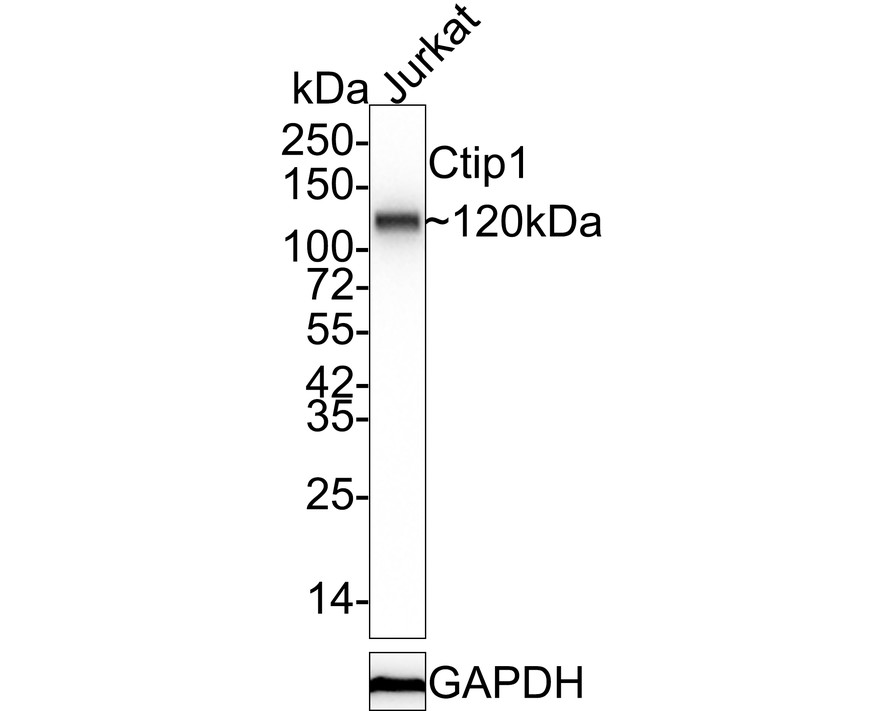
|
Fig1:
Western blot analysis of Ctip1 on Jurkat cell lysates with Rabbit anti-Ctip1 antibody (ET7107-38) at 1/5,000 dilution. Lysates/proteins at 20 µg/Lane. Predicted band size: 91 kDa Observed band size: 120 kDa Exposure time: 3 minutes; ECL: K1801; 4-20% SDS-PAGE gel. Proteins were transferred to a PVDF membrane and blocked with 5% NFDM/TBST for 1 hour at room temperature. The primary antibody (ET7107-38) at 1/5,000 dilution was used in 5% NFDM/TBST at 4℃ overnight. Goat Anti-Rabbit IgG - HRP Secondary Antibody (HA1001) at 1/50,000 dilution was used for 1 hour at room temperature. |

|
Fig2:
Western blot analysis of Ctip1 on different lysates with Rabbit anti-Ctip1 antibody (ET7107-38) at 1/1,000 dilution. Lane 1: Daudi cell lysate Lane 2: Raji cell lysate Lysates/proteins at 20 µg/Lane. Predicted band size: 91 kDa Observed band size: 120 kDa Exposure time: 20 seconds; ECL: K1801; 4-20% SDS-PAGE gel. Proteins were transferred to a PVDF membrane and blocked with 5% NFDM/TBST for 1 hour at room temperature. The primary antibody (ET7107-38) at 1/1,000 dilution was used in 5% NFDM/TBST at 4℃ overnight. Goat Anti-Rabbit IgG - HRP Secondary Antibody (HA1001) at 1/50,000 dilution was used for 1 hour at room temperature. |
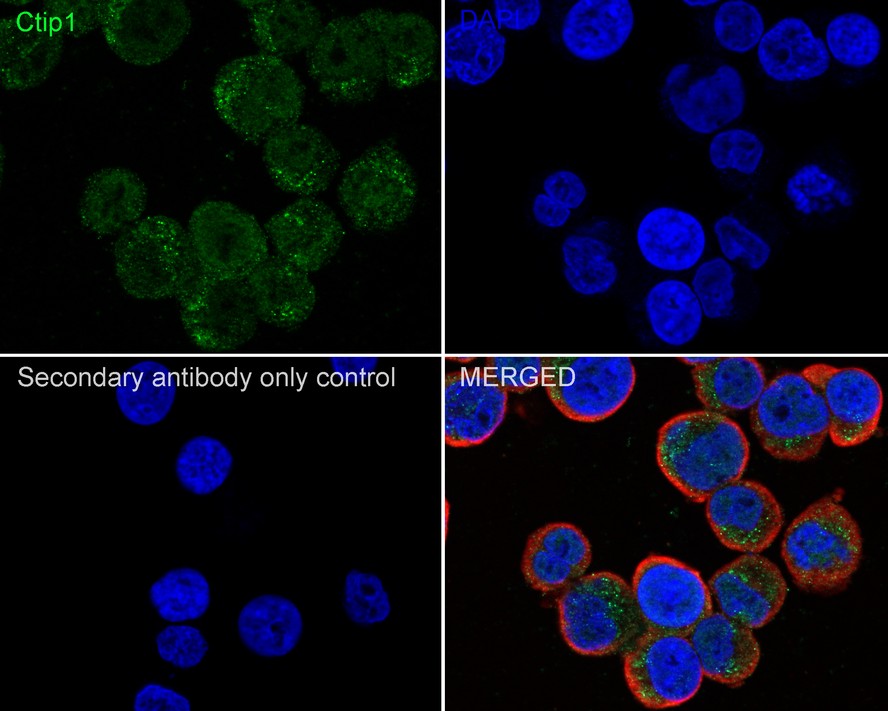
|
Fig3:
Immunocytochemistry analysis of Jurkat cells labeling Ctip1 with Rabbit anti-Ctip1 antibody (ET7107-38) at 1/100 dilution. Cells were fixed in 4% paraformaldehyde for 20 minutes at room temperature, permeabilized with 0.1% Triton X-100 in PBS for 5 minutes at room temperature, then blocked with 1% BSA in 10% negative goat serum for 1 hour at room temperature. Cells were then incubated with Rabbit anti-Ctip1 antibody (ET7107-38) at 1/100 dilution in 1% BSA in PBST overnight at 4 ℃. Goat Anti-Rabbit IgG H&L (iFluor™ 488, HA1121) was used as the secondary antibody at 1/1,000 dilution. PBS instead of the primary antibody was used as the secondary antibody only control. Nuclear DNA was labelled in blue with DAPI. Beta tubulin (M1305-2, red) was stained at 1/100 dilution overnight at +4℃. Goat Anti-Mouse IgG H&L (iFluor™ 594, HA1126) was used as the secondary antibody at 1/1,000 dilution. |
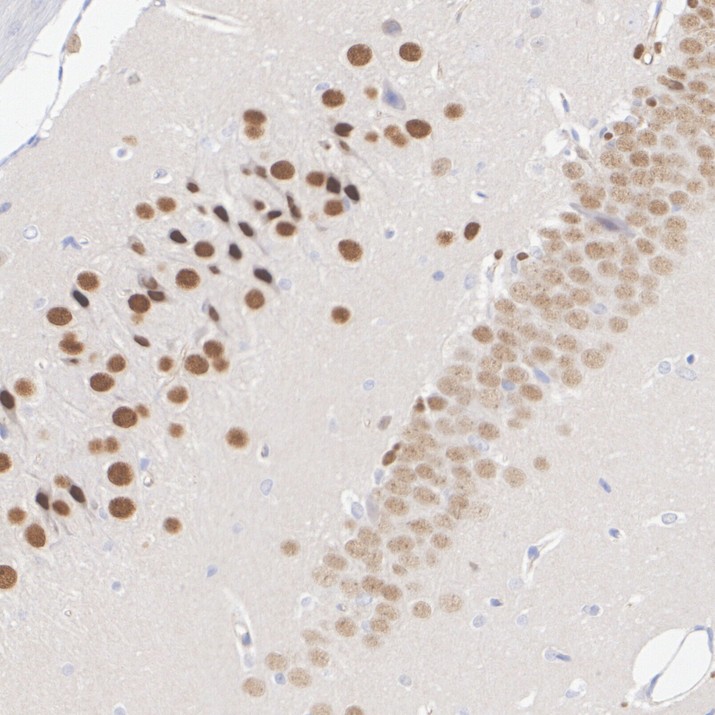
|
Fig4:
Immunohistochemical analysis of paraffin-embedded mouse brain tissue with Rabbit anti-Ctip1 antibody (ET7107-38) at 1/50 dilution. The section was pre-treated using heat mediated antigen retrieval with sodium citrate buffer (pH 6.0) (high pressure) for 2 minutes. The tissues were blocked in 1% BSA for 20 minutes at room temperature, washed with ddH2O and PBS, and then probed with the primary antibody (ET7107-38) at 1/50 dilution for 1 hour at room temperature. The detection was performed using an HRP conjugated compact polymer system. DAB was used as the chromogen. Tissues were counterstained with hematoxylin and mounted with DPX. |
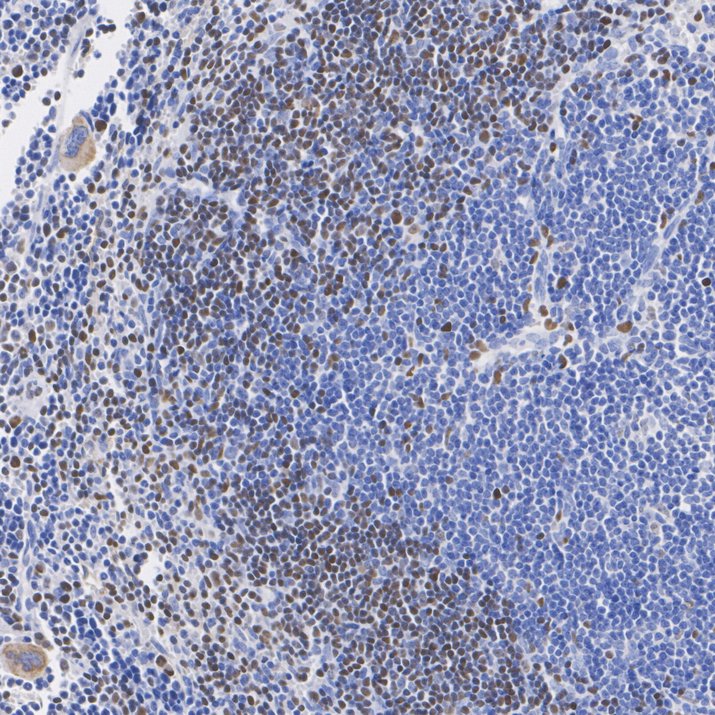
|
Fig5:
Immunohistochemical analysis of paraffin-embedded mouse spleen tissue with Rabbit anti-Ctip1 antibody (ET7107-38) at 1/50 dilution. The section was pre-treated using heat mediated antigen retrieval with sodium citrate buffer (pH 6.0) (high pressure) for 2 minutes. The tissues were blocked in 1% BSA for 20 minutes at room temperature, washed with ddH2O and PBS, and then probed with the primary antibody (ET7107-38) at 1/50 dilution for 1 hour at room temperature. The detection was performed using an HRP conjugated compact polymer system. DAB was used as the chromogen. Tissues were counterstained with hematoxylin and mounted with DPX. |
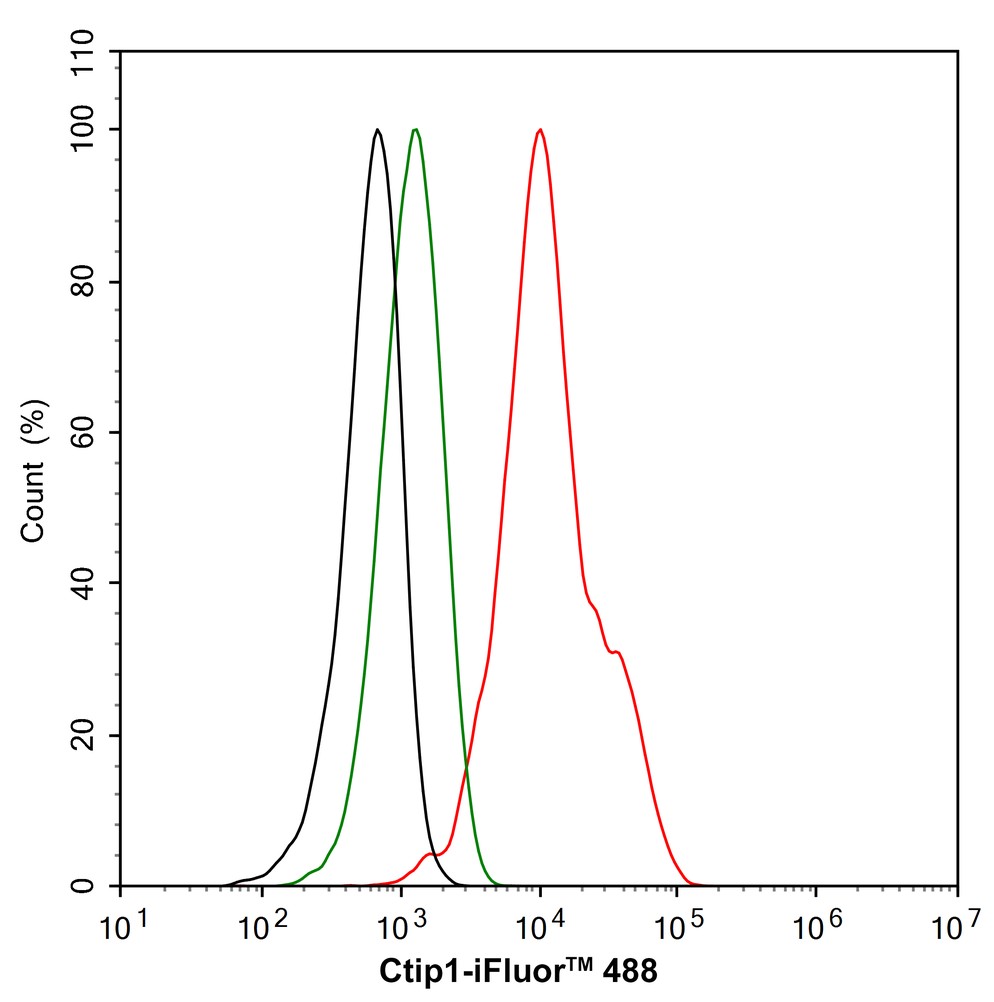
|
Fig6:
Flow cytometric analysis of Jurkat cells labeling Ctip1. Cells were fixed and permeabilized. Then stained with the primary antibody (ET7107-38, 1/1,000) (red) compared with Rabbit IgG Isotype Control (green). After incubation of the primary antibody at +4℃ for an hour, the cells were stained with a iFluor™ 488 conjugate-Goat anti-Rabbit IgG Secondary antibody (HA1121) at 1/1,000 dilution for 30 minutes at +4℃. Unlabelled sample was used as a control (cells without incubation with primary antibody; black). |
Note: All products are “FOR RESEARCH USE ONLY AND ARE NOT INTENDED FOR DIAGNOSTIC OR THERAPEUTIC USE”.